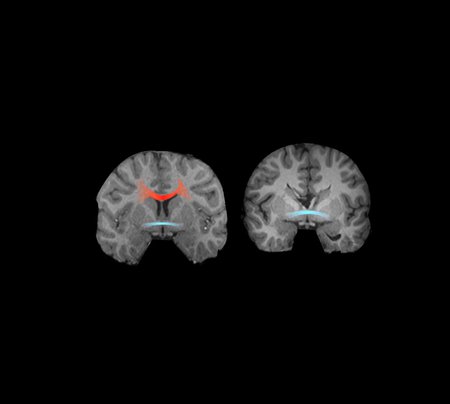Building on their prior work (see "Bridging the Gap"), a team of neuroscientists at Caltech now report that rare patients who are missing connections between the left and right sides of their brain—a condition known as agenesis of the corpus callosum (AgCC)—show a strikingly high incidence of autism. The study is the first to show a link between the two disorders.
The findings are reported in a paper published April 22, 2014, in the journal Brain.
The corpus callosum is the largest connection in the human brain, connecting the left and right brain hemispheres via about 200 million fibers. In very rare cases it is surgically cut to treat epilepsy—causing the famous "split-brain" syndrome, for whose discovery the late Caltech professor Roger Sperry received the Nobel Prize. People with AgCC are like split-brain patients in that they are missing their corpus callosum—except they are born this way. In spite of this significant brain malformation, many of these individuals are relatively high-functioning individuals, with jobs and families, but they tend to have difficulty interacting with other people, among other symptoms such as memory deficits and developmental delays. These difficulties in social behavior bear a strong resemblance to those faced by high-functioning people with autism spectrum disorder.
"We and others had noted this resemblance between AgCC and autism before," explains Lynn Paul, lead author of the study and a lecturer in psychology at Caltech. But no one had directly compared the two groups of patients. This was a challenge that the Caltech team was uniquely positioned to do, she says, since it had studied patients from both groups over the years and had tested them on the same tasks.
"When we made detailed comparisons, we found that about a third of people with AgCC would meet diagnostic criteria for an autism spectrum disorder in terms of their current symptoms," says Paul, who was the founding president of the National Organization for Disorders of the Corpus Callosum.
The research was done in the laboratory of Ralph Adolphs, Bren Professor of Psychology and Neuroscience and professor of biology at Caltech and a coauthor of the study. The team looked at a range of different tasks performed by both sets of patients. Some of the exercises that involved certain social behaviors were videotaped and analyzed by the researchers to assess for autism. The team also gave the individuals questionnaires to fill out that measured factors like intelligence and social functioning.
"Comparing different clinical groups on exactly the same tasks within the same lab is very rare, and it took us about a decade to accrue all of the data," Adolphs notes.
One important difference between the two sets of patients did emerge in the comparison. People with autism spectrum disorder showed autism-like behaviors in infancy and early childhood, but the same type of behaviors did not seem to emerge in individuals with AgCC until later in childhood or the teen years.
"Around ages 9 through 12, a normally formed corpus callosum goes through a developmental 'growth spurt' which contributes to rapid advances in social skills and abstract thinking during those years," notes Paul. "Because they don't have a corpus callosum, teens with AgCC become more socially awkward at the age when social skills are most important."
According to Adolphs, it is important to note that AgCC can now be diagnosed before a baby is born, using high-resolution ultrasound imaging during pregnancy. This latest development also opens the door for some exciting future directions in research.
"If we can identify people with AgCC already before birth, we should be in a much better position to provide interventions like social skills training before problems arise," Paul points out. "And of course from a research perspective it would be tremendously valuable to begin studying such individuals early in life, since we still know so little both about autism and about AgCC."
For example, the team would like to discern at what age subtle difficulties first appear in AgCC individuals, and at what point they start looking similar to autism, as well as what happens in the brain during these changes.
"If we could follow a baby with AgCC as it grows up, and visualize its brain with MRI each year, we would gain such a wealth of knowledge," Adolphs says.
The Brain paper, "Agenesis of the Corpus Callosum and Autism: A Comprehensive Comparison," also includes as coauthors Daniel Kennedy, assistant professor of psychology at Indiana University, and Christina Corsello, a member of the research staff at Rady Children's Hospital–San Diego. The research was funded by the Simons Foundation, Autism Speaks, and the Brain and Behavior Research Foundation.
 MRI images from a neurotypical control (left) and an adult with complete agenesis of the corpus callosum (right). The corpus callosum is indicated in red, fading as the fibers enter the hemispheres in order to suggest that they continue on. The anterior commissure is indicated by light aqua. The image illustrates the dramatic lack of inter hemispheric connections in callosal agenesis.
Credit: Lynn Paul/Caltech
MRI images from a neurotypical control (left) and an adult with complete agenesis of the corpus callosum (right). The corpus callosum is indicated in red, fading as the fibers enter the hemispheres in order to suggest that they continue on. The anterior commissure is indicated by light aqua. The image illustrates the dramatic lack of inter hemispheric connections in callosal agenesis.
Credit: Lynn Paul/Caltech

